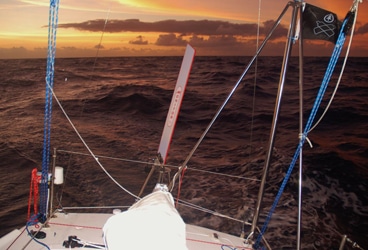
Our earth’s oceans are dominated by various trade winds, horse latitudes (aka variables) and doldrums. Starting at the equator you will find a doldrums called the ITCZ (inter tropical convergence zone), both north and south of the ITCZ are the easterly trades. The easterly trades are by far the loveliest of all the places to sail (as long as you’re going the right direction). The easterlies are close enough to the equator to provide you with warm sunny weather and since they are so far south it’s highly unlikely that you will encounter a storm. Unless its hurricane or typhoon season.
The easiest, safest ocean crossings are in the easterlies, crossing the Atlantic from the Canary Islands to the Caribbean and crossing the Pacific from either California or Panama to any of the beautiful islands in Polynesia. Moving away from the easterly trades things become a bit more complicated.
From roughly 25 to 40 north (especially in the northern hemisphere) you will find the horse latitudes, or as it’s more professionally called, “the variables”. In this area that stretches 1,500 miles north to south the wind can blow out of any direction, you can get stormy weather, and you can be becalmed. After the variables at around 40 north or 40 south you get into the westerly trade winds. In the southern hemisphere the westerly trades have nick names like “roaring 40′s” and “screaming 60′s”. The westerly trades are much windier, wetter and more difficult. If you go any further north or south than the westerlies, you wind up in the Arctic or Antarctic.
One of the interesting aspects of sailing around the Americas is I had to sail through every one of these regions, sometimes against the prevailing winds. Sailing from California to Hawaii is a downwind sleigh ride, once you find the easterly trades. I know a guy who built a raft out of plastic trash and more or less drifted from California to Hawaii, it took him 88 days but he made it. After Hawaii, heading for Japan, things become a bit more complicated.
At this point we have sailed more miles than it would take to get from Annapolis Maryland to England, and we are only halfway there. We have been making good time averaging 120-135 miles a day, which is very good considering we are dragging a net doing research, and I’m a super conservative sailor. I never push a boat harder than it wants to be pushed (unless I’m trying to run away from a storm). I remember sitting at a bar in Annapolis 5 or 6 years ago listening to some guy bragging about how he had sailed across the Atlantic in 16 days. What I found out later is that he destroyed a brand new set of sails, broke this and broke that, he put 30,000 miles of wear and tear on his boat in a 3,000 mile crossing. Who cares how long it takes to get from point A to point B, blue water sailing is not about the destination, it’s about the journey.
The Harbor 29 has been holding up well, although there was one small issue. New standing rigging will stretch and become loose. That’s typically not an issue, you just tighten the rigging at the turnbuckles. The problem is this boat has a semi high performance double spreader rig. The upper inner shrouds became loose and the only way to tighten them is to climb that mast. Normally this would be an easy thing to do, but climbing a mast under sail, then reaching out to the end of the spreader with a tool in each hand is a nightmare. You have to use two wrenches to tighten the rigging so how are you going to hold on to the mast? Luckily I received an ATN mast climber right before I left. This device lets you climb a mast comfortably without having someone winch you up. At a dock it would have taken 20 minutes to tighten the rigging but since the mast was like riding a bucking bronco it took two hours. I never would have been able to do it without the mast climber. You can’t have too many safety devices.
Halfway through this crossing and the ocean is starting to take its toll on my body. The salty air attacked my scalp and I had to cut all the hair of my head and face. My scalp looks like it has been burned and I’m as bald as a Buddhist monk. Since the boat is small I find myself sitting a sweating a lot, so I now have an epic heat rash in the last place you want a heat rash. I’ve dealt with this before on previous expeditions, it’s just part of being a Celt, you have sensitive skin. Nicole on the other hand has no problems and is holding up just fine.
I doubt we will be able to keep making such good mileage. We already had to turn south, looking for better wind as the trades were dying off a bit. I hope to stay in the easterlies all the way to 155-150 east, than sail northwest to Japan. My plans don’t mean much to Poseidon, only time will tell.
We believe that while no one can do everything, everyone can do something. Our project is committed to serving the ocean research community. We provide data that explores man’s relationship with our planet’s oceans. Learn more about the Ocean Research Project at www.oceanresearchproject.org.








